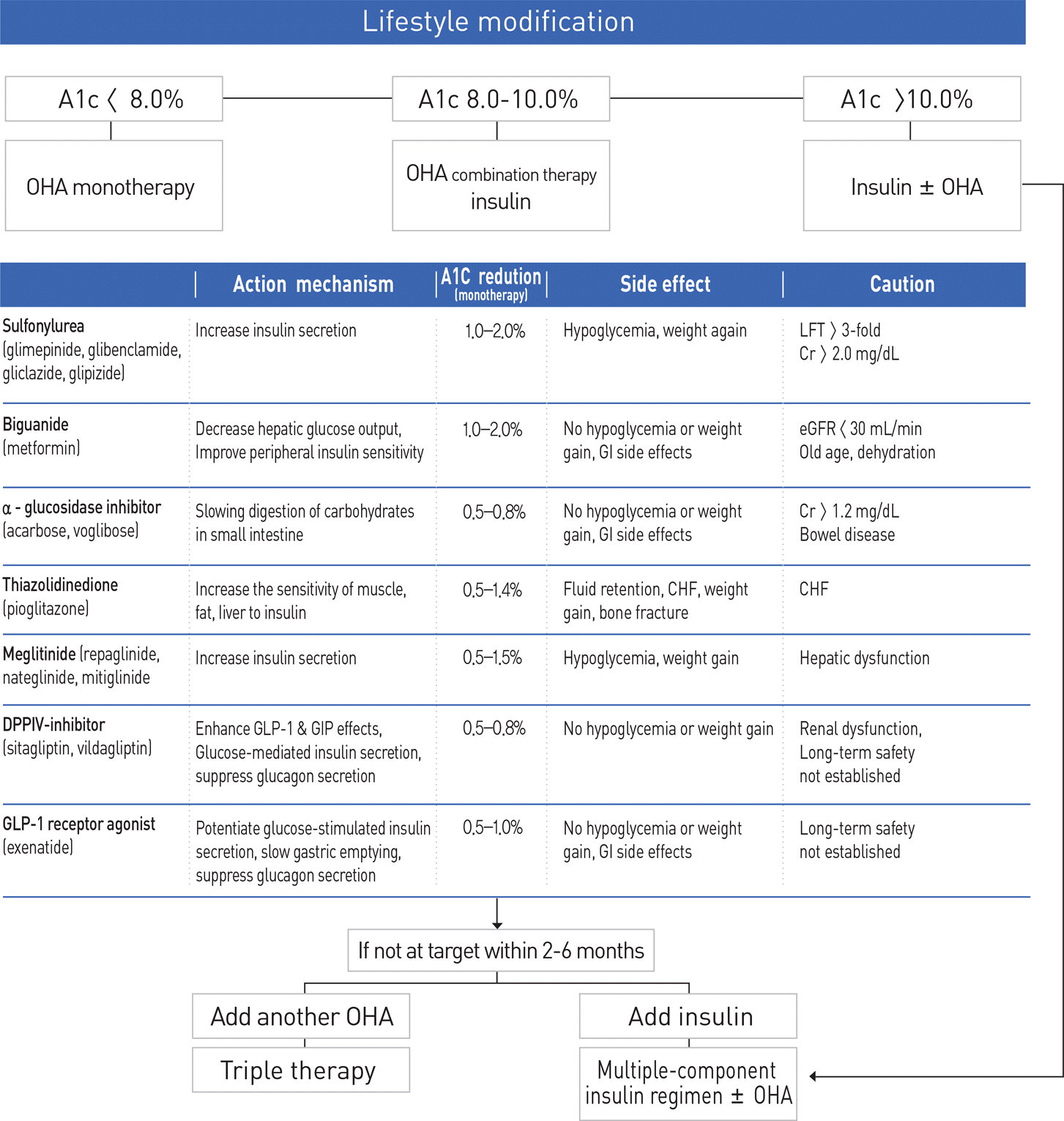Abstract
The Committee of Clinical Practice Guidelines of the Korean Diabetes Association revised and updated the ‘3rd Clinical Practice Guidelines’ at the end of 2010. In these guidelines, the committee recommends active screening of high risk individuals for early detection and added HbA1c level as a diagnostic criterion of type 2 diabetes to produce a more practical approach based on clinical studies performed in Korea. Furthermore, committee members emphasize that integrated patient education for self-management is an essential part of patient care. The drug treatment algorithm was also updated based on the degree of hyperglycemia and patient characteristics.
Go to : 
REFERENCES
1. Yoon KH, Lee JH, Kim JW, Cho JH, Choi YH, Ko SH, Zimmet P, Son HY. Epidemic obesity and type 2 diabetes in Asia. Lancet. 2006; 368:1681–8.

03. SStatistics Korea. e-National indicators: 2009 statistical results about cause of death [Internet]. Daejeon: Statistics Korea;2009. [cited 2011 Sep 5]. Available from:. http://www.index.go.kr.
4. Korean Diabetes Association. Diabetes in Korea 2007. Report of Task Force Team for basic statistical study of Korean diabetes mellitus. Seoul: Korean Diabetes Association;2007.
5. Oh JY, Lim S, Kim DJ, Kim NH, Kim DJ, Moon SD, Jang HC, Cho YM, Song KH, Park KS. Committee of the Korean Diabetes Association on the Diagnosis and Classification of Diabetes Mellitus. The diagnosis of diabetes mellitus in Korea: a pooled analysis of four community-based cohort studies. Diabet Med. 2007; 24:217–8.

6. Oh JY, Lim S, Kim DJ, Kim NH, Kim DJ, Moon SD, Jang HC, Cho YM, Song KH, Ahn CW, Sung YA, Park JY, Shin C, Lee HK, Park KS. Committee of the Korean Diabetes Association on the Diagnosis and Classification of Diabetes Mellitus. A report on the diagnosis of intermediate hyperglycemia in Korea: A pooled analysis of four community-based cohort studies. Diabetes Res Clin Pract. 2008; 80:463–8.

7. Choi KM, Lee J, Kim DR, Kim SK, Shin DH, Kim NH, Park IB, Choi DS, Baik SH. Comparison of ADA and WHO criteria for the diagnosis of diabetes in elderly Koreans. Diabet Med. 2002; 19:853–7.

8. Choi YH, Yoon KH, Cha BY, Lee KW, Son HY, Kang SK. Classification of diabetes mellitus according to NDDG and ADA diagnostic criteria and comparison of insulin secretion. In: 50th Korean Association of Internal Medicine Meeting;. 1998. Oct; Seoul.
9. Kim DJ, Song KE, Park JW, Cho HK, Lee KW, Huh KB. Clinical characteristics of Korean type 2 diabetic patients in 2005. Diabetes Res Clin Pract. 2007; 77(Suppl 1):S252–7.

10. American Diabetes Association. Standards of medical care in diabetes-2010. Diabetes Care. 2010; 33(Suppl 1):S11–61.
11. Hanas R, John G. International HBA1c Consensus Committee. 2010 consensus statement on the worldwide standardization of the hemoglobin A1C measurement. Diabetes Care. 2010; 33:1903–4.

12. Song J, Kwon KC, Kim JH, Kim JW, Min WK, Lee SY, Lee EH, Jun SH, Choi TY. Annual report on external quality assessment in metabolic disorders in Korea (2008). J Lab Med Qual Assur. 2009; 31:143–59.
13. Bae JC, Rhee EJ, Choi ES, Kim JH, Kim WJ, Yoo SH, Park SE, Park CY, Lee WY, Oh KW, Park SW, Kim SW. The cutoff value of HbA1c in predicting diabetes in Korean adults in a university hospital in Seoul. Korean Diabetes J. 2009; 33:503–10.

14. Ku YH, Yoo SH, Jung HS, Lim S, Moon MK, Choi SH, Jang HC, Park KS, Kim SY, Lee HK, Cho YM. Diagnostic value of HbA1c different clinical setting with different prevelence of diabetes mellitus. Korean Diabetes J. 2008; 32(suppl 8):S311.
15. Kim KS, Kim SK, Lee YK, Park SW, Cho YW. Diagnostic value of glycated haemoglobin HbA(1c) for the early detection of diabetes in high-risk subjects. Diabet Med. 2008; 25:997–1000.

16. Ohkubo Y, Kishikawa H, Araki E, Miyata T, Isami S, Motoyoshi S, Kojima Y, Furuyoshi N, Shichiri M. Intensive insulin therapy prevents the progression of diabetic microvascular complications in Japanese patients with non-insulin-dependent diabetes mellitus: a randomized prospective 6-year study. Diabetes Res Clin Pract. 1995; 28:103–17.

17. Effect of intensive blood-glucose control with metformin on complications in overweight patients with type 2 diabetes (UKPDS 34). UK Prospective Diabetes Study (UKPDS) Group. Lancet. 1998; 352:854–65.
18. Intensive blood-glucose control with sulphonylureas or insulin compared with conventional treatment and risk of complications in patients with type 2 diabetes (UKPDS 33). UK Prospective Diabetes Study (UKPDS) Group. Lancet. 1998; 352:837–53.
19. Skyler JS, Bergenstal R, Bonow RO, Buse J, Deedwania P, Gale EA, Howard BV, Kirkman MS, Kosiborod M, Reaven P, Sherwin RS. American Diabetes Association; American College of Cardiology Foundation; American Heart Association. Intensive glycemic control and the prevention of cardiovascular events: implications of the ACCORD, ADVANCE, and VA diabetes trials: a position statement of the American Diabetes Association and a scientific statement of the American College of Cardiology Foundation and the American Heart Association. Diabetes Care. 2009; 32:187–92.
Go to : 
 | Fig. 1.Algorithm for the medical management of type 2 diabetes. OHA, oral hypoglycemic agents; LFT, liver function test; GI, gastrointestinal; eGFR, estimated glomerular filtration rate; CHF, congestive heart failure; DPP, dipeptidyl peptidase; GLP, Glucagonlike peptide; GIP, glucose-dependent insulinotropic peptide. |
Table 1.
Screening of diabetes in Korea
Table 2.
Diagnostic criteria for diabetes in Korea
Normal activity should be maintained for at least three days before sampling.
In the absence of unequivocal hyperglycemia, blood sampling should be repeated.
FPG, fastingc plasma glucose.
a Glucose load containing the equivalent of 75 g of anhydrous glucose dissolved in water.
b “Random” is defined without regard to the time since the last meal.
c “Fasting” means no caloric intake for at least 8 hr.
Table 3.
Recommendation of glycemic target in patients with type 2 diabetes




 PDF
PDF ePub
ePub Citation
Citation Print
Print


 XML Download
XML Download